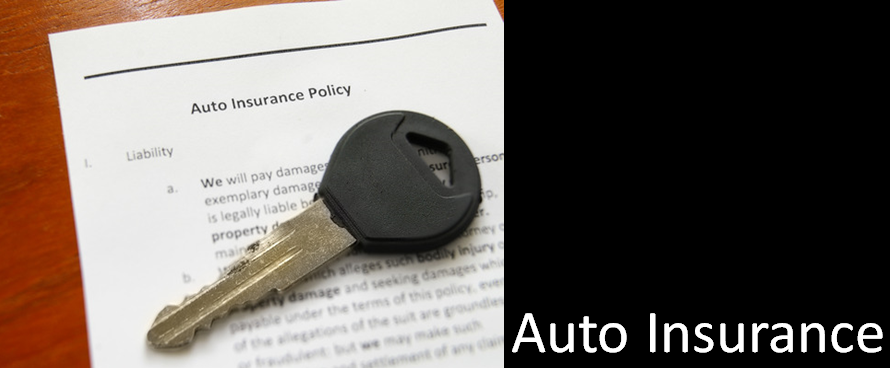You have to face that no matter how lucky you are, throughout your life you will have some unfortunate and expensive financial incidents. The good news is that there are different types of insurance products that will make these one-time financial burdens less costly when they happen. When it comes to insurance, there are many unnecessary products out there, too, but there are a few that, statistically, are worth having. We’ll look at the most important types of insurance that you need in your day-to-day life, and what you need to know about these types of insurance. You’ll have to decide which kind of coverage you want, and where to save on your premiums, so you can put that money to work for you in dividend-paying stocks.

Many people live day to day without thinking about the inevitable that will occur sometime down the road. However, at some point in your life you should evaluate (or reevaluate) the financial issues that may occur when you or a spouse dies, as you never know what life might have in store for you. That being said, it is important to examine the various life insurance types available. An unexpected death can happen, with the deceased leaving behind unpaid debts and liabilities that the immediate family may not be able to honor. This sudden and unfortunate event can be especially burdensome when the person that passes away is the breadwinner in the family. Because of all of this uncertainty, having a solid life insurance plan is a must for almost everyone.
Who Needs Life Insurance?
Life insurance is not necessarily for everyone. Depending on certain situations and financial health, there are those who may not need the added expense of insurance. Though there are some that do not need a life insurance plan, a good general rule is that if you are a parent then you should have a life insurance policy that covers you until your youngest child completes college. For additional tips, check out Suze Orman’s How do I protect my spouse if something happens to me?
You should keep in mind that it’s not only the primary financial provider that needs to have a life insurance policy; many homemakers and stay-at-home parents have an economic value that might be a burden on a family in they were to pass away. For instance, the price of childcare can be an unforeseen expense that a family needs in this situation. So keep in mind that unpaid work isn’t overlooked when planning for a life insurance policy.
Over time, the demand for a life insurance plan may fluctuate. It is a good idea to go back and reevaluate your policy every five years or so to make sure the plan covers the needs of your current situation. Events like the birth of a new child, inheritance of a large sum of money or assets, or even just the obvious life changes as you age, can all affect the need and price of life insurance plans over time. If you’re looking into life insurance, you may also want to read about the Downside of Annuities.
What Drives Up Costs?
Prior to finalizing any life insurance plan, you will most likely have to go through a background check mandated by the insurance company. This check includes a medical exam and an overview of your lifestyle. Many factors in the background check can go into your life insurance plan price.
Preexisting medical conditions, risky hobbies, vices such as smoking and drinking, and the like, all play a role in determining the cost of a life insurance plan. If an insurer believes you live a life that is more likely to result in an early death, then they will drive up the price. After all, insurers make their money when you don’t pass away and keep paying into the life insurance plan. If they believe you are at risk of an earlier death, then they will charge you more to make up for it.
Not only does a certain lifestyle drive up premium costs, different life insurance plans come with different premiums. The two main types of life insurance plans are term life insurance and permanent life insurance. Term life insurance is the more basic and cheaper of the two. Permanent life insurance is more complex with a variety of components that cause monthly costs to be more expensive. Another way to make sure you have some savings to leave for your family is through dividend investing. Find out what you need to know in 40 Things Every Dividend Investor Should Know About Dividend Investing.
Term Life Insurance
Term life insurance is one of the most affordable insurance policies. The policy is for a set period of time: 5, 10, 20 years or more. The monthly premiums you pay, which stay the same over the period of the plan, cover the cost of the life insurance. If you were to pass away during the period of the coverage, then the face value of the policy would be covered by the life insurance and paid to the beneficiary.
After the term of the policy expires, coverage ends. However, these term life insurance policies can be renewed or even rolled over to a permanent life insurance plan.
The downside to term life insurance is that there is no way to build up cash value that can be distributed or borrowed from. You pay a set, low premium and get the insurance of agreed upon face value plan and that is it. On the other hand, permanent life insurance allows for savings and investment components in addition to the insurance that can result in a substantial cash build-up over time.
Permanent Life Insurance
When it comes to permanent life insurance plans, the details become a bit more complicated than term life insurance. These plans offer lifetime coverage; however, the monthly premiums cost more and can vary. As stated above, these plans do offer savings and investment components, in addition to the insurance. These additional components are part of the reason for the high monthly premiums, as the insurance company takes an allocation of the money and invests it in mutual funds, bonds or equities. This investment component allows for a build up of wealth within the policy as returns and interest accrue. Savings components of permanent life insurance plans allow for a build up of cash value that you can withdraw from or borrow against.
There are three types of permanent life insurance; each has its own nuances that could make it more attractive to you given your situation.
- Whole Life Insurance: This plan includes lifetime insurance protection as well as a savings component with a fixed rate to build up a cash value. You pay one monthly premium and the insurance company allocates the money to cover the insurance costs with the rest going to the savings component.
- Universal Life Insurance: This plan is a lot like a whole life insurance policy, except it gives the policy owner the choice on how to allocate the monthly premium to the insurance component and the savings element.
- Variable Life Insurance: Variable life policies are more risky as they give the policy owner more flexibility when it comes to the investment component of the insurance plan. Here, the policy owner has more control when determining where to invest the investment portion of monthly premiums.

Health insurance is a policy that pays for your health costs in exchange for paying monthly premiums. When obtaining a health insurance policy it’s important to understand what it covers and to get the coverage that is most applicable. Some of the different health costs that can be covered are drug plans, different types of treatments for diseases, giving birth and extended hospital stays.
The two types of health insurance plans that are usually offered are the following:
- Indemnity Plan – this covers hospital stays, surgery and major medical procedures. The coverage will usually be a percentage of total costs.
- HMOs – This is like the indemnity plan, but there will be limitations on the doctors that you are able to use. This type of heath insurance plan is what is usually offered through workplace-sponsored healthcare plans, and is usually the most affordable.
There are other plans available (PPOs, POS), and they will have their own benefits and limitations. Look into what will work for you and your family, and take into account the incredibly expensive costs that are associated with serious surgeries and long-term illnesses.
Long-Term Care Insurance
The skyrocketing costs of health care and other services for the elderly have many people worried about how they or their loved ones will spend their final years, especially those with limited resources. Medicare and Medicaid are already sorely overloaded and cannot be counted on to cover this cost. Long-term care insurance was introduced as a way for consumers to avoid becoming burdened with these expenses.
Long-term care refers to the array of services required by those who become unable to care for themselves. Although this need is typically associated with the elderly, it can also apply to younger people who become disabled or suffer from long-term illness. LTC encompasses various types of extended living assistance, ranging from simple services such as in-home cleaning, meal preparation and regular visitations to in-home health care or skilled nursing care, which administers regular medical treatments to patients, and finally to full-time care such as hospice and nursing home care.
Costs
The price of the labor and the equipment that is used to care for the infirm has grown at a rate substantially above the general rate of inflation for many years, and this trend is not likely to change any time soon. A year in a nursing home can easily run anywhere from $50,000 to $150,000, depending upon such factors as geographical location and the services that are provided at the facility. Home healthcare services can also costs thousands of dollars a month, even for simple services such as assistance with transference or bathing, and the price for any type of skilled care is much higher. An elderly person that does not have a specific affliction but who needs some form of care for five years can run up a $200,000 bill before all is said and done. Below are the average costs for various services according to the Genworth 2014 Cost of Care Survey.
| Service | Average Rate (2014) |
|---|---|
| Homemaker Services | $19 (hourly) |
| Home Health Aide Services | $20 (hourly) |
| Adult Day Heath Care (ADC) | $65 (daily) |
| Assisted Living Facility (ALF) | $3,500 (monthly) |
| Nursing Home Care (semi-private room) | $212 (daily) |
| Nursing Home Care (private room) | $240 (daily) |
Characteristics
Long-term care policies are designed to pay out a monthly benefit that will cover the cost of caring for elderly policy owners for an extended period of time during their declining years. These policies can cover virtually all types and levels of needs and services and are offered by many different carriers. Policy benefits are usually triggered when the insured(s) becomes physically incapable of performing a certain number (usually at least two or more) of the following six activities of daily living (ADL):
- Eating
- Dressing
- Toileting (getting on/off the toilet)
- Transference (to or from a bed)
- Bathing
- Continence
There are two major types of LTC policies on the market today. The first type of policy is known as an indemnity policy, which simply pays out a fixed amount up to a certain limit, irrelevant of the actual cost of care. Pooled care policies are more flexible and have a total dollar limit that can be used to pay for any type of amount of care until the policy limit is reached, although they typically have limits as to what can be paid out over a given period of time such as a week, month or year. Benefits from either type of policy are typically paid out for a set period of time, such as one to three years or until no longer needed.
The deductible for this type of policy generally comes in the form of a waiting period, which in most cases will range anywhere from one to six months. As with any type of insurance coverage, the benefits provided by a policy are commensurate with its cost. A more expensive policy will pay out higher benefits for a longer period of time and have a shorter waiting period. For example, a purchaser could choose a daily benefit of anywhere from $50 to $300 for care in a nursing home, with a lower range for home health services.
Good policies are guaranteed renewable, which means that the premiums cannot go up in later years if the health of the policy owner declines. They will also cover most if not all major types of services either at home or in an appropriate facility, and consumers should look for policies that waive the premiums once a claim is filed. As mentioned previously, the rate of inflation for LTC is very high, and therefore a cost-of-living (COLA) rider is also often recommended for policy owners. Most LTC policies today are also tax-qualified, which means that the cost of their premiums can be deducted as a medical expense on Schedule A of the 1040.
Should I Buy LTC Insurance?
The cost of LTC insurance varies. To get a good idea on how much the average cost in your state is, click here..
Although the cost of paying for LTC coverage can be high, it is not practical for everyone to carry this coverage. Those with low to moderate incomes and few or no assets may qualify for Medicaid, while those with substantial assets may be wise to protect them with a LTC policy. Those who are unsure whether this is a good idea for them should sit down with a financial planner to examine their circumstances and objectives.

Homeowners insurance is a definite must if you own your own home, and rental insurance is usually a solid decision depending on the value of your possessions. For homeowners insurance, you’ll need enough coverage for the following:
- The replacement value of your home and your belongings
- Protecting yourself from lawsuits that result from property negligence
- Mortgage (if required by your lender)
Though these are the main things you need covered, you should go over your policy to make sure it covers damage to other properties around yours that are caused by your home (i.e. a flood seeps into your neighbor’s home); living expenses, if your home is damaged and unlivable you’ll want your insurance to cover the cost of staying in a hotel; medical costs of your family or someone else who is injured on your property and you are deemed responsible.
For the actual coverage of the value of your home, there are a number of ways that this works, as there is replacement value, actual value and guaranteed replacement cost. You’ll have to decide which one works best for your family, as these policies will all cost different amounts and you will approach it differently depending on whether you have appreciating or depreciating property and possessions. This cost will fluctuate depending on the policies you want, where you live and the cost of your home and possessions. To estimate the cost of homeowners insurance, check out this homeowner insurance calculator.
Renters insurance protects all of your possessions if they are stolen or damaged. The cost for renters insurance is much less than homeowners insurance, and can run about $20 per month, but should cover up to $100,000 worth of possessions. It’s an affordable and necessary insurance type that you will want to get if you can afford it.
Most Expensive States for Homeowners Insurance
| State | Average Annual Cost |
|---|---|
| Washington | $626 |
| Wisconsin | $592 |
| Utah | $563 |
| Oregon | $559 |
| Idaho | $518 |
Least Expensive States for Homeowners Insurance
| State | Average Annual Cost |
|---|---|
| Florida | $1,933 |
| Louisiana | $1,672 |
| Texas | $1,578 |
| Mississippi | $1,409 |
| Oklahoma | $1,386 |

The cost and particulars for auto insurance will depend on what kind of car you have, how experienced you are as a driver and what types of auto insurance you want to pay for. One thing to keep in mind is that most policies will have deductibles, so you’ll want to find the right balance between the premium you pay and the deductible you’ll have to pay if you get into an accident.
The most important part of auto insurance is the personal liability insurance, which can cover the costs of injury or property damage that the driver has caused. Though the amount of insurance isn’t always legally enforced, it’s important to have enough bodily injury and property damage insurance to realistically cover costs in an accident. When you’re getting your auto insurance, check with your insurance company to find the right balance between coverage and premium costs. The last thing you want to do is to skimp out on $5 worth of premiums per month and then be on the line for thousands of dollars in damage that your policy won’t cover.
Collision protection can be optional depending on how much your car is worth. Because your property damage insurance will cover other cars in an accident, collision is really to replace your own vehicle. If you’re driving an older model car, you’ll want to run the numbers on whether it’s worth getting collision insurance. When looking into insurance, you’ll want to make sure that your coverage will also cover a rental car’s costs in case you get into an accident and are unable to use your car, and medical costs (if you don’t have health insurance).
Aside from your age, gender and driving record, credit score and general riskiness are assessed by your insurers to decide what kind of rate you should be paying. The safer your car is and the statistics on how often it’s stolen will also factor into your insurance rate. Be sure to shop around when getting your insurance, and check different insurance companies each year to see what kind of rate you will be offered. Find out how to reduce your car insurance costs in How To Lower Your Car Insurance.
The Car Accident Checklist to Avoid Financial Pains Later
Here are the key things you will need to get to avoid any complications with your insurance company, and to ensure you have the least financial and legal complications following the accident.
- Keep your auto insurance information in the glove compartment, including a pre-printed form or plain piece of paper that you can fill out in order to provide the particulars of any accident. Having this form on hand will remind you of what needs to be recorded, and will help you to keep things straight at a time when you won’t be thinking straight.
- It is important to limit your discussion of the accident and not to admit any fault or liability. You should talk about the accident with the police and your insurance agent only. This might seem like a cold thing to do, especially if you and the other person involved in the accident are waiting around for the authorities to arrive, but it’s best to not admit any fault.
- Wait for the police to come and be sure you have the name of the officer(s) and that they have your version of what happened. It seems obvious, but even if you’re in a rush, and you think that the damage caused is negligible, it’s illegal to leave the scene of an accident, and could land you in a way worse position than if you wait and are late to whatever even you were driving to.
- Exchange names, addresses, driver’s license and insurance information with the driver of the other car. Young drivers are more likely to be in an accident than experienced drivers; find out what you need to know about getting insurance for teenage drivers in Insurance And Financial Considerations For A First-Time Teen Driver.
- Call your agent or insurance company’s 800-number immediately, even at the scene with the police if possible. Sometimes the police officer can give your insurance company more accurate information rather than information you may not be recording properly because you are upset by the accident.
- Take pictures of all vehicles involved from multiple angles. Your cell phone camera (especially if you have a newer smartphone), will be of sufficient quality to come in handy later.
- Once the insurance company has contacted you back to go over what they will and will not pay for, make sure you review your policy to make sure you’re getting everything you’ve paid for. If you don’t understand any part of your policy or claim, call your insurance company for a thorough explanation. You may be entitled to a loaner car if you are unable to drive your car. It’s important to know your policy inside and out to save on huge costs like weeks of car rentals.
- Insurance companies often try to give you estimates of losses that are lower than your actual losses. Don’t accept their estimates without getting some estimates of your own. Find a mechanic or body shop that you trust (ask friends or check Internet rating sites to find someone honest), and make sure you get a second opinion before accepting the insurance company’s estimate.
The Bottom Line
There are many types of insurance out there, and even more providers, so make sure you figure out what is right for you and your family before diving in. In this article we’ve gone over the most important types of coverage that you will need in your day-to-day life. Whether you want less or more insurance is totally up to you, just make sure you know the costs of getting it and the risks of going without.





